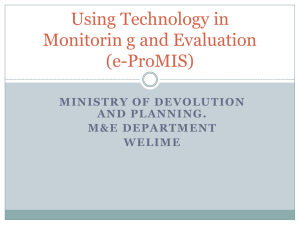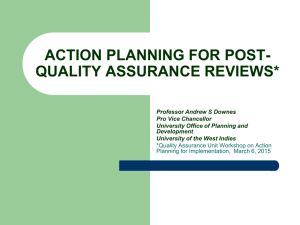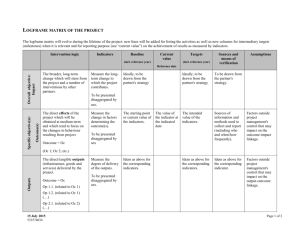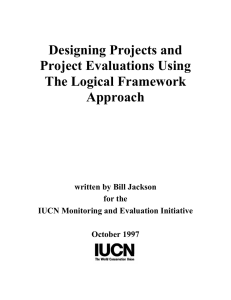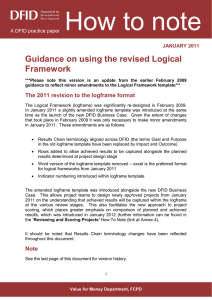The Elements of a Monitoring and Evaluation System
advertisement
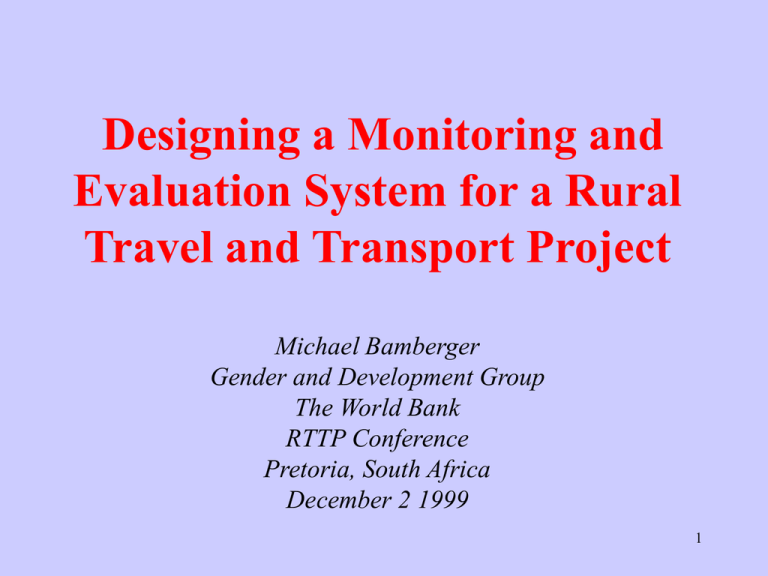
Designing a Monitoring and Evaluation System for a Rural Travel and Transport Project Michael Bamberger Gender and Development Group The World Bank RTTP Conference Pretoria, South Africa December 2 1999 1 A good M/E system helps ensure that a project • Is being efficiently implemented • Is reaching the intended target groups • Is achieving its intended objectives 2 A good M/E system will Monitor the use of project inputs Monitor the effectiveness of the project implementation process Monitor the production of project outputs Assess project impacts on the target communities Assess the effectiveness of project outputs in producing the intended short-term and long-term impacts. Assess the extent to which these impacts can be attributed to the effects of the project. 3 An RTT M/E system should • Extract lessons and best practices for the design of future projects • Provide guidelines for the modification of project design • Provide adequate data for the evaluation of program impact 4 The Basic Monitoring and Evaluation Model 5 Figure 1 Monitoring and Evaluation Model of the Project Implementation Process Economic and Political context within which the project is implemented Project planning and Inputs Project Implementation process Institutional context within which the project is implemented Project outputs Project impacts Project sustainability Socio-economic characteristics of the communities affected by the project 6 Stages of the project cycle covered by the M/E system • • • • • Project planning and inputs Implementation process Output Short and long term impacts Project sustainability 7 Project implementation and impacts are also affected by • The organizational and institutional context • The economic and political context • The social and economic characteristics of the communities 8 Figure 3 Apply the Monitoring and Evaluation Model to the Tanzania Village Travel and Transport Project Economic and Political context within which the project is implemented Project Inputs Road construction , donkey, bicycles, construction of water pumps, technical assistance Project Implementatio n process Focus groups, community management groups including women, training, female extension workers Institutional context within which the project is implemented Project outputs Improved and new roads and footpaths, women use bicycles and donkeys, handpumps, grinding mills. Short and long term impacts travel time reduced, easier access to markets, , more children attend school, income increases, women enter labor market, women’s status in family enhanced Sustainability Infrastructure maintained Stronger community groups Networks created Cost-recovery Agencies more gender sensitive Socio-economic characteristics of the communities affected by the project 9 Key questions for designing a M/E system • What indicators should be used to measure and monitor each stage of the project? • How should the information be collected? • How to measure quality and effectiveness? • How and when to communicate findings to managers and stakeholders? 10 Key questions continued…. • How do we assess the benefits and impacts produced by the project? • How to assess whether pilot projects have been successful. 11 Developing and using indicators Good indicators should • Cover all stages of the project cycle • Provide essential information needed to monitor progress, identify problems and assess results • Provide information which can easily be used by managers and policy makers • Be objective and easily measurable • Include the minimum number possible 12 Examples of indicators for a feeder road project • Planning and inputs • Implementation process • Outputs • • • • Stakeholder groups consulted Funds approved and available Equipment available All community included in planning and implementation • Targets set for women representatives • Local organizations established at district level • Km. Roads constructed/ upgraded 13 Feeder road indicators page 2 • Impacts • Increased household income • Higher proportion of girls attending school • Increased agricultural production • Wider range of goods available in villages 14 Feeder road indicators page 3 • Sustainability • Cash payments for road maintenance • Community labor for road maintenance • Condition of roads 1, 2 and 5 years after construction 15 M/E systems must identify all stakeholders and ensure their information needs are covered. • All community groups affected by the project • Local government agencies • National government agencies • NGOs • International development agencies 16 Evaluation studies and evaluation systems 17 Individual M/E studies can be conducted each using the methods best suited to the particular issue being studied 18 But to assess the overall progress of a program involving many different activities …. An evaluation system is required Logical framework analysis [LOGFRAME] Is one of the best methods for setting up a monitoring and evaluation system LOGFRAME helps define the basic assumptions on which the project design and implementation systems are based. 21 LOGFRAME monitors the following logical sequence of activities…… 22 If certain inputs are used effectively then certain outputs will be produced if the outputs are produced then certain impacts will be achieved 23 Example Using LOGFRAME to monitor and evaluate the impacts of a feeder road on women 24 If feeder roads are upgraded then women will take more agricultural produce to market then household income will increase and women’s economic status will improve 25 Main kinds of M/E studies See Handout Annex I for details Question 1. 2. 3. Are RTTP activities being implemented on schedule? Are women fully involved in all stages? Are the activities producing their intended benefits? Study • Monitoring study • Gender responsiveness assessment study • Impact evaluation 26 Main kinds of studies page 2 Question 4. Are the activities sustainable? 5. Were the pilot interventions successful and could they be replicated? Study • Sustainability assessment • Replicability assessment 27



